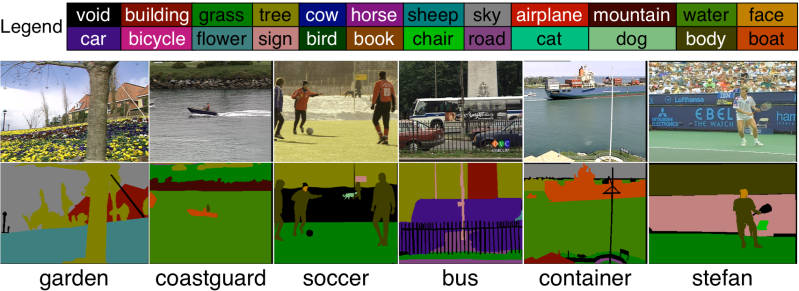
Jason J. Corso
| Snippets by Topic | |
| * | Active Clustering |
| * | Activity Recognition |
| * | Medical Imaging |
| * | Metric Learning |
| * | Semantic Segmentation |
| * | Video Segmentation |
| * | Video Understanding |
| Selected Project Pages | |
| * | Action Bank |
| * | LIBSVX: Supervoxel Library and Evaluation |
| * | Brain Tumor Segmentation |
| * | CAREER: Generalized Image Understanding |
| * | Summer of Code 2010: The Visual Noun |
| * | ACE: Active Clustering |
| * | ISTARE: Intelligent Spatiotemporal Activity Reasoning Engine |
| * | GBS: Guidance by Semantics |
| * | Semantic Video Summarization |
| Data Sets | |
| * | YouCook |
| * | Chen Xiph.org |
| * | UB/College Park Building Facades |
| Other Information | |
| * | Code/Data Downloads |
| * | List of Grants |
Multi-Class Label Propagation in Videos
The effective propagation of pixel labels through the spatial and
temporal domains is vital to many computer vision and multimedia
problems, yet little attention has been paid to the temporal/video
domain propagation in the past. We have begun to explore this
problem in the context of general real-world "videos in the wild"
and surveillance videos. Our current efforts primarily focus on
mixing motion information with appearance information
Previous video label propagation
algorithms largely avoided the use of dense optical flow estimation
due to their computational costs and inaccuracies, and relied
heavily on complex (and slower) appearance models.
Label Propagation Benchmark Dataset


We used a subset of the videos from xiph.org as the basis of our benchmark
dataset for label propagation. Existing datasets either restricted
the study to two classes or were taken in restricted settings, such
as from the dash of a moving vehicle. Our new data set has general
motion and presents stratified levels of complexity. We continue to
add to the labels and will release additional videos in the future.
For more information, see Albert
Chen's page.
Download the full data set.
Code
Code from our WNYIPW paper is here
with the config
file. Or you can get the dataset above and the code is in the
package.
If you use the dataset or the code, the associated cite is below.
If you use the dataset or the code, the associated cite is below.
Publications
| [1] | A. Y. C. Chen and J. J. Corso. Propagating multi-class pixel labels throughout video frames. In Proceedings of Western New York Image Processing Workshop, 2010. [ bib | .pdf ] |
Acknowledgements
This work is partially support by NSF CAREER IIS-0845282 [project
page].